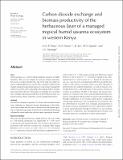| dc.contributor.author | GO K’Otuto, DO Otieno, B Seo, HO Ogindo, JC Onyango | |
| dc.date.accessioned | 2020-08-31T08:49:49Z | |
| dc.date.available | 2020-08-31T08:49:49Z | |
| dc.date.issued | 2013-08-01 | |
| dc.identifier.uri | https://repository.maseno.ac.ke/handle/123456789/2606 | |
| dc.description.abstract | Aims
Humid savannas, as a result of high precipitation amounts, are highly productive. They are also hotspots for land use change and potential sources of carbon dioxide (CO2) due to the large soil carbon (C) stocks. Understanding how ecosystem CO2 exchange is influenced by changes arising from agricultural land use is vital in future management of these ecosystems and in responding to the ongoing shifts in management and climate. The aim of this study was to identify how ecosystem CO2 exchange and biomass productivity of the herbaceous layer of a humid savanna in Kenya respond to current management practices.
Methods
We used flux chambers to quantify CO2 fluxes, while monthly harvests were undertaken to determine biomass development of the herbaceous layer of three sites that were (i) fenced to exclude livestock grazing, (ii) subjected to grazing by … | en_US |
| dc.publisher | Oxford University Press | en_US |
| dc.subject | tropical humid savanna, abandoned croplands, biomass production, ecosystem CO2 exchange, livestock grazing, soil water content | en_US |
| dc.title | Carbon dioxide exchange and biomass productivity of the herbaceous layer of a managed tropical humid savanna ecosystem in western Kenya | en_US |
| dc.type | Article | en_US |

